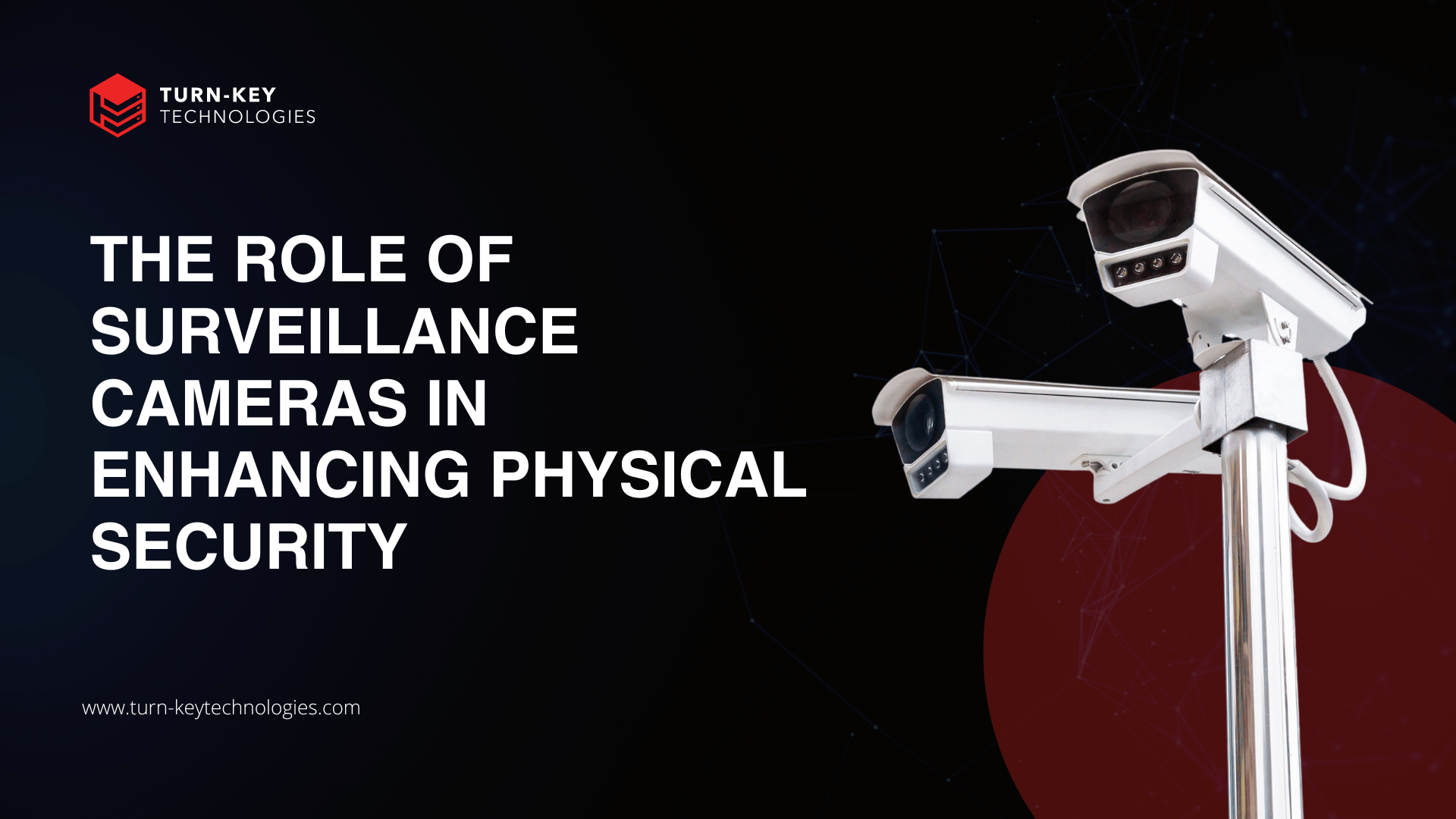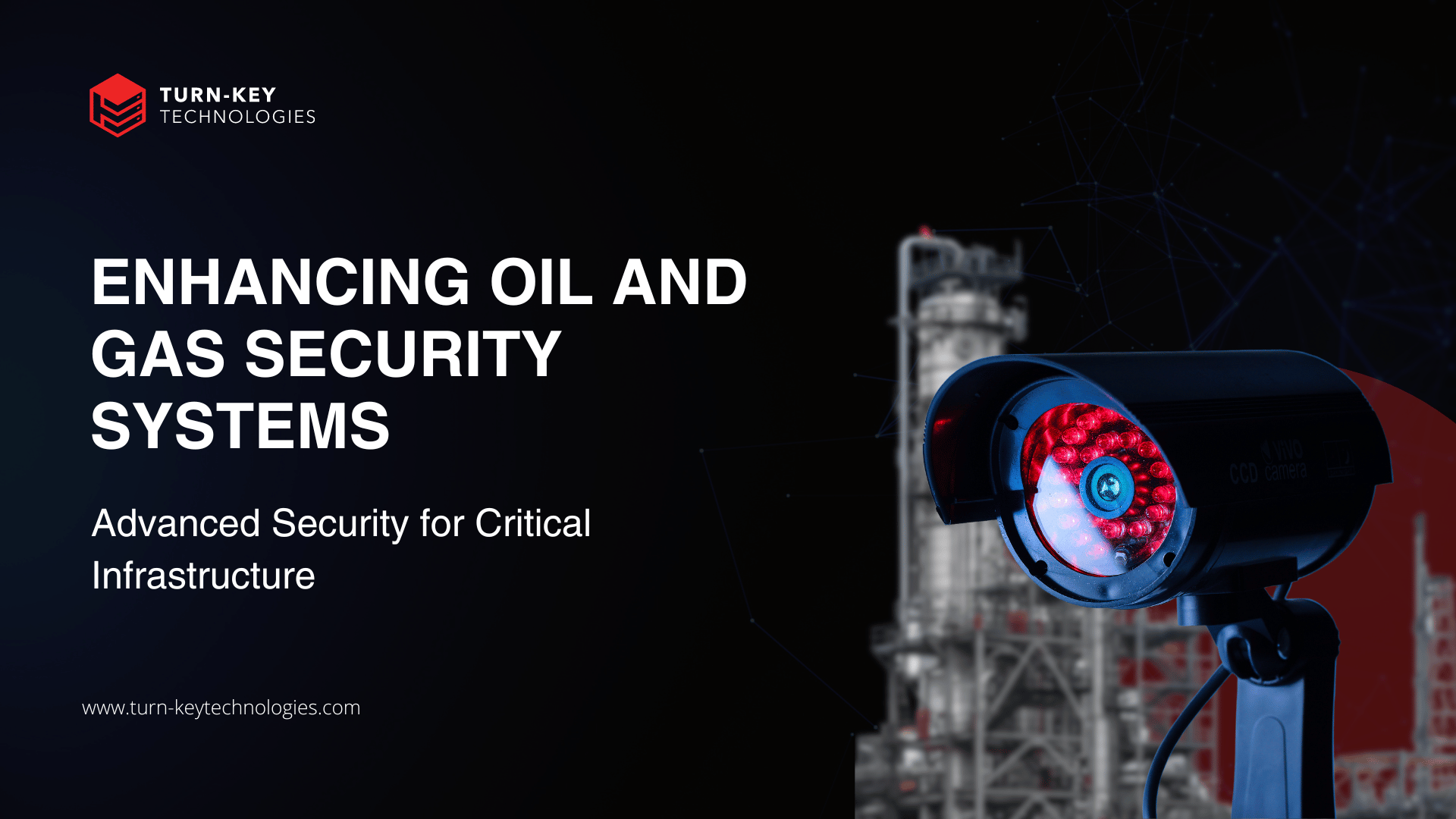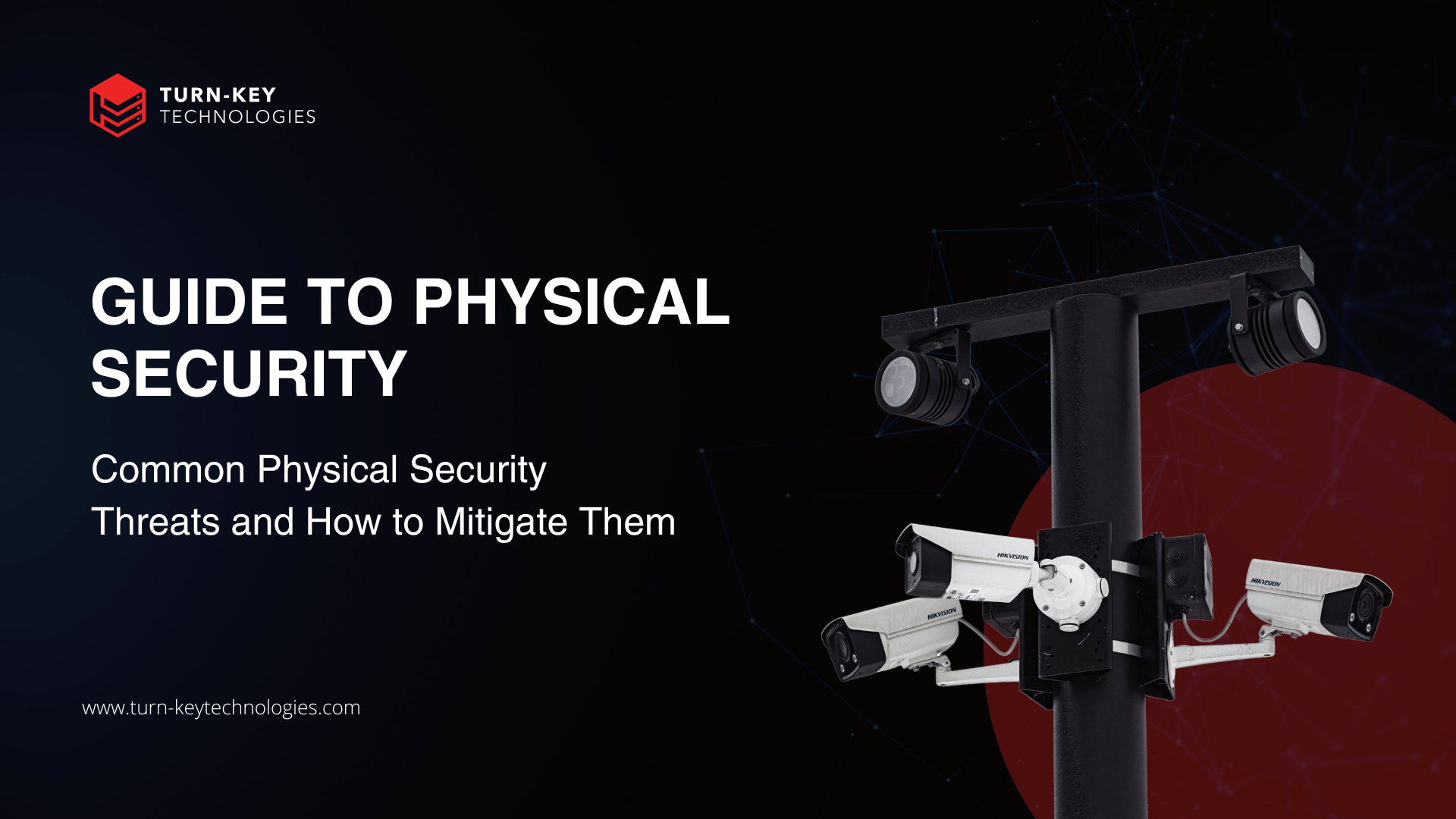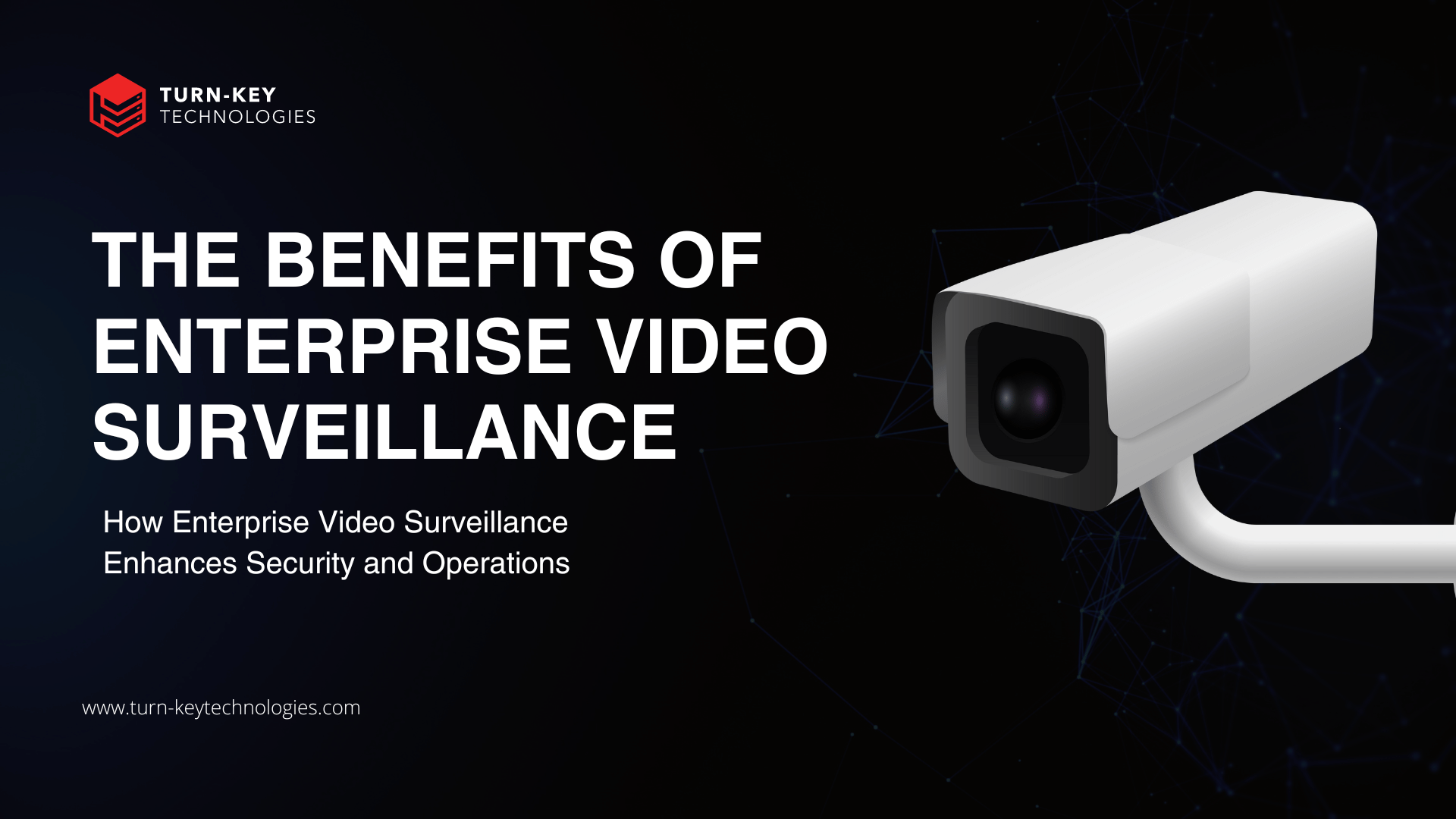Enhancing Oil and Gas Security Systems: Advanced Security for Critical Infrastructure
The oil and gas industry is a cornerstone of global energy supply and economic stability, making infrastructure security paramount. From pipelines to...
11 min read
Turn-key Technologies Staff : Jul 10, 2024 12:12:00 PM

The physical security market is experiencing significant growth, with projections indicating it will expand at a CAGR of 8.03% from 2023 to 2028, reaching a market size of $278.1 billion by 2032. This growth underscores the increasing importance of physical security in today’s world. Effective physical security is crucial for protecting people, property, and information from a wide range of threats, including unauthorized access, theft, vandalism, and natural disasters. By implementing measures such as physical barriers, surveillance systems, access control mechanisms, and security personnel, organizations can create a secure environment that not only prevents incidents but also ensures swift responses when they occur. This blog post dives into the essential components of physical security and their role in safeguarding against various threats.
TL;DR: Physical security protects against unauthorized access, theft, vandalism, and natural disasters using barriers, surveillance, access controls, and security personnel. It creates a secure environment through prevention, real-time monitoring, and swift incident responses.
Physical security involves protecting people, property, and information from physical threats such as unauthorized access, theft, vandalism, and natural disasters. It includes various measures designed to safeguard physical assets from harm, such as physical barriers, surveillance systems, access control mechanisms, and security personnel, all working together to create a secure environment.
At its core, physical security aims to prevent unauthorized access to facilities and sensitive areas. This is achieved through physical barriers like fences, gates, and locks, as well as electronic access control systems that regulate who can enter and exit specific areas. Advanced access control systems use technologies such as key cards, biometric scanners, and PIN codes to authenticate individuals and ensure only authorized personnel gain access.
Surveillance systems, including security cameras, are another critical component of physical security. These systems monitor and record activities in real-time, providing valuable footage for incident investigation and deterrence. Modern security cameras come equipped with features like high-definition resolution, night vision, and AI-powered analytics, enhancing their ability to detect and respond to security threats.
Alarm systems play a crucial role in alerting security personnel and emergency responders to potential security breaches. These systems can be configured to trigger alarms in response to unauthorized access, motion detection, or environmental changes, such as smoke or temperature fluctuations. Alarms enable a quick response to incidents, minimizing potential damage and ensuring the safety of occupants.
Physical security also involves the deployment of security personnel, who provide a human element to security operations. Security guards conduct patrols, monitor surveillance feeds, and respond to incidents, ensuring compliance with security protocols. Their presence acts as a deterrent to potential criminals and enhances the overall effectiveness of the security system.
Physical security is essential for protecting people, property, and sensitive information from threats like unauthorized access, theft, vandalism, and natural disasters. These threats can cause significant harm, financial loss, and operational disruptions. Effective physical security measures create a safe environment, maintaining the integrity and functionality of facilities and operations.
Visible security measures, such as surveillance cameras, security guards, and access control systems, deter potential criminals. These components signal that an area is well-protected, reducing the likelihood of criminal activities. For instance, businesses with robust physical security are less likely to experience theft or vandalism, saving costs associated with loss and damage.
Physical security is also crucial for compliance with regulations and industry standards. Many industries, such as healthcare, finance, and critical infrastructure, have specific physical security requirements. Compliance ensures the protection of sensitive data and operational continuity, while failure to comply can result in legal penalties, financial loss, and damage to an organization’s reputation.
In emergencies, physical security measures provide a first line of defense. Access control systems can prevent unauthorized entry during security breaches, surveillance cameras can provide real-time footage to emergency responders, and alarm systems can alert occupants to evacuate during fires or other emergencies, potentially saving lives and minimizing injury.
Moreover, physical security contributes to operational efficiency and peace of mind. When employees and clients feel safe, they are more productive and confident in their environment. This positive atmosphere enhances a business's reputation, attracts customers, and increases employee retention. Effective physical security allows organizations to focus on their core activities without constant worry about potential threats.
Physical security threats encompass a wide range of risks that can compromise the safety and integrity of physical assets, facilities, and individuals. Understanding these common threats is crucial for developing effective security measures to mitigate them. This blog explores some of the most prevalent physical security threats and their potential impact on organizations.
One of the most common physical security threats is unauthorized access. This occurs when individuals gain entry to restricted areas without permission, often leading to theft, vandalism, or espionage. Unauthorized access can result from weaknesses in access control systems, such as outdated locks, easily duplicated keys, or inadequate monitoring of entry points. Implementing robust access control measures, such as biometric scanners and electronic key cards, can significantly reduce the risk of unauthorized access.
Theft and burglary are persistent threats targeting valuable assets, equipment, and sensitive information. These incidents can occur in both commercial and residential settings, leading to financial losses and operational disruptions. Thieves often exploit vulnerabilities in physical barriers, such as weak doors, windows, and fencing. To combat theft, organizations should invest in strong physical barriers, alarm systems, and surveillance cameras to deter and detect criminal activities.
Vandalism is another common physical security threat that can cause significant damage to property and infrastructure. Acts of vandalism can range from graffiti and property defacement to the destruction of equipment and facilities. Vandalism incurs repair costs, disrupts operations, and affects the perception of safety. Effective measures to prevent vandalism include adequate lighting, visible security cameras, and regular security patrols to monitor and protect vulnerable areas.
Natural disasters, such as fires, floods, earthquakes, and severe weather events, pose significant physical security threats. These events can cause extensive damage to buildings, infrastructure, and critical systems, leading to prolonged operational downtimes and financial losses. Organizations must have comprehensive emergency preparedness plans, including fire detection and suppression systems, flood barriers, and structural reinforcements. Regular drills and training for employees on emergency response procedures are also essential.
Lastly, insider threats are a critical aspect of physical security that often goes overlooked. Employees, contractors, or visitors with legitimate access to facilities can intentionally or unintentionally cause security breaches. Insider threats can involve theft, sabotage, or the sharing of sensitive information. To mitigate this risk, organizations should implement strict access control policies, conduct background checks, and promote a culture of security awareness among employees. Monitoring and auditing access logs can also help identify and address potential insider threats.
A comprehensive physical security system is essential for protecting people, property, and assets from various threats. It consists of several key components that work together to create a secure environment. Understanding these components helps in designing and implementing effective security measures tailored to an organization's specific needs.
Physical barriers form the first line of defense in a physical security system. These include fences, gates, walls, and bollards, which prevent unauthorized access to a facility or property. By creating clear boundaries and entry points, physical barriers make it more challenging for intruders to gain access. Additionally, the use of barbed wire and other deterrents can enhance perimeter security, further reducing the risk of breaches.
Access control systems are crucial for regulating who can enter and exit specific areas within a facility. These systems use various technologies, such as key cards, biometric scanners, and PIN codes, to authenticate individuals and grant access based on predefined permissions. Advanced access control systems can integrate with other security components, such as surveillance cameras and alarm systems, to provide a comprehensive security solution. By restricting access to sensitive areas, these systems help prevent unauthorized entry and protect valuable assets.
Surveillance systems, including security cameras and video monitoring equipment, are vital for continuous monitoring and recording of activities within and around a facility. Modern surveillance systems are equipped with high-definition cameras, night vision capabilities, and AI-powered analytics that can automatically detect and alert security personnel to suspicious activities. Surveillance footage serves as valuable evidence in the event of a security incident and can help in identifying and prosecuting offenders.
Alarm systems are designed to alert security personnel and emergency responders to potential security breaches. These systems can be triggered by various events, such as unauthorized access, motion detection, or environmental changes like smoke or temperature fluctuations. Alarm systems provide real-time notifications, enabling a quick response to incidents and minimizing potential damage. Integrating alarm systems with access control and surveillance systems enhances their effectiveness and ensures comprehensive coverage.
Security personnel, including security guards and monitoring staff, play a critical role in a physical security system. They provide a human element that complements technological security measures. Security guards conduct regular patrols, monitor surveillance feeds, and respond to incidents, ensuring that security protocols are followed. Their presence acts as a deterrent to potential criminals and enhances the overall security posture of the organization.
A robust physical security system comprises physical barriers, access control systems, surveillance systems, alarm systems, and security personnel. Each component plays a vital role in protecting people, property, and assets from various threats. By integrating these elements and adopting best practices, organizations can create a secure environment that deters potential intruders, ensures compliance with regulations, and protects valuable assets.
Developing a comprehensive physical security plan is essential for protecting an organization's assets, personnel, and information. The process begins with conducting a thorough risk assessment to identify potential threats, vulnerabilities, and their likelihood of occurring. This helps prioritize security measures based on the level of risk and the criticality of assets. Once risks are identified, it’s important to define security objectives and requirements, such as preventing unauthorized access and ensuring the safety of personnel. These objectives guide the development of specific security measures and policies.
Next, design and implement appropriate security measures based on the risk assessment and security objectives. This includes physical barriers like fences and locks, access control systems such as key cards and biometric scanners, surveillance systems like security cameras, and alarm systems. Ensure these measures are integrated to work seamlessly together, enhancing overall security effectiveness. Alongside implementing these measures, it’s crucial to establish and communicate comprehensive security policies that outline procedures for access control, visitor management, incident response, and emergency procedures. Regular training and drills ensure everyone understands their roles and responsibilities in maintaining security.
The final step is to regularly review and update the physical security plan. This ongoing process involves periodic audits, drills, and adjustments to address new threats, organizational changes, and advancements in security technology. By staying proactive and adaptable, organizations can ensure their physical security plan remains effective in mitigating risks and protecting their assets, personnel, and information. This structured approach to developing a physical security plan creates a robust framework for comprehensive protection against physical threats.
Implementing best practices for physical security is essential for creating a secure environment that protects people, property, and information from various threats. Regular security audits are vital for identifying vulnerabilities and areas for improvement within a physical security system. These audits assess all aspects of the security infrastructure, including access control systems, surveillance cameras, physical barriers, and alarm systems. By conducting thorough inspections and tests, organizations can uncover weaknesses that may not be immediately apparent and address them before they are exploited. Regular audits help ensure that security measures remain effective and up-to-date with evolving threats.
A layered security approach, or defense in depth, involves implementing multiple layers of security controls to protect assets. This strategy ensures that if one layer is breached, additional layers remain in place to deter or delay intruders. For example, a facility might use physical barriers like fences and gates, access control systems at entry points, and surveillance cameras for continuous monitoring. By combining different security measures, organizations create a more robust and resilient security posture.
Creating a security-conscious culture within the organization is crucial for the success of physical security measures. This involves regularly training employees on security policies, procedures, and best practices. Employees should be encouraged to remain vigilant and report any suspicious activities or security concerns. Promoting awareness and responsibility ensures that all staff members contribute to maintaining a secure environment. Clear communication of security policies and regular reinforcement through training sessions help foster this culture.
Leveraging advanced security technologies can significantly enhance the effectiveness of physical security measures. Modern security systems, such as biometric access control, AI-powered surveillance cameras, and integrated alarm systems, offer greater accuracy and efficiency in detecting and responding to threats. For instance, AI-powered analytics can automatically identify unusual activities and alert security personnel in real-time. Investing in cutting-edge technologies helps organizations stay ahead of potential threats and ensures a more proactive security approach.
Having well-defined and regularly updated emergency response plans is crucial for ensuring a swift and effective response to security incidents. These plans should outline procedures for various scenarios, such as intrusions, natural disasters, and fire emergencies. Regular drills and simulations prepare employees and security personnel for real-life situations, ensuring that everyone knows their roles and responsibilities. Effective communication strategies, coordination with law enforcement, and clear evacuation routes are essential components of an emergency response plan.
Best practices for physical security involve conducting regular audits, implementing layered security measures, fostering a security-conscious culture, utilizing advanced technologies, and maintaining comprehensive emergency response plans. By following these practices, organizations can create a secure environment that effectively protects their assets, personnel, and information from various physical threats. Continuous improvement and adaptation to emerging threats are key to maintaining robust physical security.
Access control is a critical component of physical security, playing a vital role in safeguarding facilities, assets, and personnel. By regulating who can enter and exit specific areas, access control systems help prevent unauthorized access, ensuring that only authorized individuals can access sensitive areas. These systems enhance physical security in several significant ways.
Access control systems restrict unauthorized entry by using various authentication methods such as key cards, biometric scanners, and PIN codes. These technologies ensure that only individuals with the correct credentials can gain access to protected areas. By doing so, access control systems reduce the risk of unauthorized individuals entering restricted zones, thereby preventing potential security breaches, theft, and vandalism.
Furthermore, access control systems provide detailed logs of all entry and exit activities, which are invaluable for monitoring and auditing purposes. These logs allow security personnel to track who accessed specific areas and when, facilitating the investigation of any security incidents. This level of accountability ensures that any unauthorized or suspicious activity can be quickly identified and addressed, enhancing the overall security posture of the organization.
Advanced access control systems can also be integrated with other security technologies such as surveillance cameras and alarm systems. This integration enables a comprehensive security approach where access control events can trigger additional security responses. For example, if an unauthorized access attempt is detected, the system can automatically alert security personnel and activate nearby surveillance cameras to record the event. This cohesive approach enhances the effectiveness of the entire security infrastructure.
Moreover, access control systems can be tailored to meet the specific needs of different areas within a facility. For example, higher-security zones can require multiple authentication factors, such as a combination of key card access and biometric verification, providing an additional layer of security. This flexibility allows organizations to implement varying levels of security based on the sensitivity and importance of different areas, ensuring maximum protection where it is needed most.
Security cameras and surveillance systems are essential components of modern physical security strategies, providing continuous monitoring and recording of activities within and around facilities. They play a crucial role in deterring crime, assisting in incident investigations, and enhancing overall situational awareness.
The presence of security cameras acts as a powerful deterrent to potential criminals. Knowing they are being watched and recorded makes would-be intruders and vandals think twice before committing any unlawful acts. This deterrence effect is especially significant in high-traffic areas and locations with valuable assets, where the risk of theft and vandalism is higher.
Surveillance systems provide invaluable evidence in the event of a security incident. High-definition cameras capture detailed footage that can be used to identify perpetrators, understand the sequence of events, and support law enforcement investigations. This video evidence is crucial for resolving disputes, prosecuting offenders, and making informed security decisions.
Modern surveillance systems, equipped with advanced features like night vision, motion detection, and AI-powered analytics, significantly enhance security operations. Night vision cameras ensure that surveillance is effective even in low-light conditions, while motion detection capabilities trigger alerts and recording only when activity is detected, conserving storage space and reducing the need for constant monitoring. AI-powered analytics can automatically identify unusual activities, such as unauthorized access or loitering, and send real-time alerts to security personnel.
The integration of surveillance systems with other security technologies, such as access control and alarm systems, creates a comprehensive security network. This integration allows for coordinated responses to security incidents. For example, if an access control system detects unauthorized entry, nearby cameras can automatically focus on the entry point, and alarms can notify security personnel. This seamless coordination enhances the efficiency and effectiveness of security operations.
The integration of cyber and physical security is becoming increasingly essential as organizations face sophisticated threats targeting both digital and physical assets. By combining traditional physical security measures with advanced cybersecurity protocols, a comprehensive security strategy addresses multiple vulnerabilities.
Enhancing overall threat detection and response capabilities is a primary benefit of integrating cyber and physical security. For instance, linking access control systems with cybersecurity protocols ensures that only authorized personnel can access both physical spaces and digital networks. If an unauthorized attempt is detected, simultaneous physical security measures, such as locking doors, and cybersecurity measures, such as blocking network access, can be activated. This dual-layered approach significantly reduces the risk of breaches.
The convergence of cyber and physical security also improves incident management and response by providing a holistic view of security events. Integrated systems allow security teams to correlate physical and cyber incidents effectively. For example, if a network breach is detected, security cameras can be directed to specific areas to capture real-time footage of the breach attempt, offering valuable information for investigation and response.
Moreover, this integration increases operational efficiency by enabling centralized monitoring and control. A unified security management platform allows organizations to monitor and manage both physical and cybersecurity systems from a single interface. This centralization simplifies security management, reduces response times, and enhances coordination between physical security teams and IT departments.
Additionally, integrating cyber and physical security ensures comprehensive protection of critical infrastructure. Many critical systems, such as power grids and transportation networks, rely on both physical and digital components. A unified security strategy helps protect these systems from a wide range of threats, ensuring continuous operation and reliability. For example, sensors and IoT devices used in physical security can feed data into cybersecurity systems to detect anomalies and potential threats.
Physical security is crucial for protecting people, property, and information from a variety of threats such as unauthorized access, theft, vandalism, and natural disasters. It involves implementing measures like physical barriers, surveillance systems, access control mechanisms, and security personnel. By understanding and effectively deploying these elements, organizations can create a secure environment that deters intruders, ensures regulatory compliance, and protects valuable assets.
If you're seeking a top-tier vendor for enterprise video surveillance systems to enhance physical security, look no further than Turn-key Technologies, Inc. (TTI). With the expertise of our professionals, you can have a reliable security camera system and robust network up and running swiftly. Our unique PAVTAC offering provides unparalleled support, including ongoing training, regular check-ins, troubleshooting assistance, and peace of mind beyond installation. When you purchase an Avigilon security camera from us, we ensure you stay informed about new features and perform annual on-site inspections to keep your system in optimal condition.
Ready to evaluate security surveillance systems for your business? Contact us today!

The oil and gas industry is a cornerstone of global energy supply and economic stability, making infrastructure security paramount. From pipelines to...

Physical security is essential for safeguarding people, property, and information from threats like unauthorized access, theft, vandalism, and...

1 min read
Did you know that a recent industry report found that over 40% of business institutions have identified significant vulnerabilities within their...